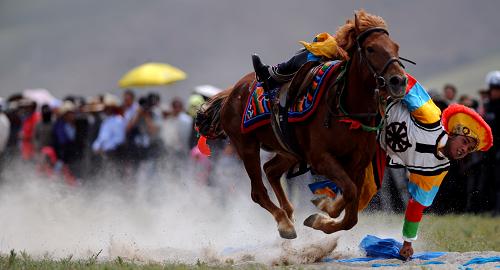
Equestrians present the horse riding skills for local Tibetans. [Photo/Xinhua]
Horses have been good companions of the Tibetan people for generations. Therefore, festivals themed in horse race are imperative. The horse racing festivals are held in many areas, among which, Changtang (Nagqu), Gyangtse, Damxung and Tingri Horse Racing Festivals are most famous.
Among all, the Gyangze Dama (Horse Racing and Archery) Festival can date back to 500 years ago, initially for consecrating the Gyangze Prince Dharma Gungsang Raodainpo, who had the Palkor Monastery and Palkor Dagoba built, as well as to his highly esteemed grandfather.
At the beginning, it was mainly for religious events, and later on evolved to horse race as a predominating event and it spread over to Lhasa, Changtang and Gongbo, etc. The festival actually begins with religious events such as mantra reciting, holy dancing and displaying images of Buddha, etc, between the 30th day of the third Tibetan month and the 18th day of the fourth month each year.
Then it proceeds to horse race on the l8th and l9th, and archery contests on 20th and 2lst. Besides, there are also some other events for fun included such as yak race, donkey race and so on. Availing themselves of the golden opportunity, merchants of different levels are also busy with their trading. In short, all the people in Gyangze city abandon themselves to jubilees in this period.
The Qiangtang Kyagqen Horse Race Festival is also very famous. Compared to that of Gyangze, the vast expanse of grassland in Northern Tibet is more suitable for horse race. Making full use of this natural condition, people here hold the event annually, which is similar to that of Gyangze, but more thrilling and exciting, because the riders here are younger.
